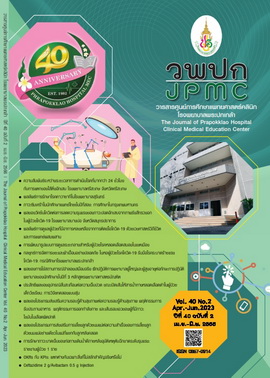Outcomes of Care Model for Patients with Residual Symptoms of COVID-19 Infection with Lifestyle Medicine and Integrative Medicine
Main Article Content
Abstract
BACKGROUND: Lifestyle medicine has been recognized as a cost-effective treatment for managing chronic illnesses. The residual symptoms of COVID-19 infection are chronic conditions that affect patients' quality of life in the short and long term.
OBJECTIVES: To assess the outcomes of a care model for patients with persistent symptoms of COVID-19 infection when treated with lifestyle medicine and integrative medicine
METHODS: One group pretest–posttest research was conducted among 20 volunteers aged 20-60 with a history of COVID-19 infection. The patients’ primary symptoms included fatigue and/or dyspnea after recovering from COVID-19 with mMRC (Modified Medical Research Council) Dyspnea Scale≥2. All patients received an individualized lifestyle modification program to suit their body element (Chao Roen) and integrative medicine once a week for 4 weeks.
RESULTS: At the end of therapy, the severity of fatigue (Visual Analogue Fatigue Scale) and dyspnea (mMRC) decreased significantly from 5.50 (5.00-6.50) to 1.00 (0.00-1.00) (p<0.001) and from 2.8±0.4 to 0.8±0.4 (p<0.001), respectively. Insomnia severity (Insomnia Severity Index) decreased dramatically from 10.50 (5.50-18.50) to 1.00 (0.00-2.00) (p<0.001). A better quality of life (EQ-5D-5L score) was observed.
CONCLUSIONS: Implementing a care model for patients with residual symptoms after COVID-19 infection, by providing behavioral modification based on lifestyle medicine in conjunction with integrative treatment, might improve patients' clinical outcomes, sleep, and quality of life. This care model should be extended to other hospitals; however, treatment duration should be designed based on the clinical symptoms of each patient. Moreover, it is important to develop skilled human resources regarding lifestyle medicine.
Thaiclinicaltrials.org number, TCTR20230314001
Article Details

This work is licensed under a Creative Commons Attribution-NonCommercial-NoDerivatives 4.0 International License.
References
Gautret P, Million M, Jarrot PA, Camoin-Jau L, Colson P, Fenollar F, et al. Natural history of COVID-19 and therapeutic options. Expert Rev ClinImmunol 2020;16:1159-84.
Lopez-Leon S, Wegman-Ostrosky T, Perelman C, Sepulveda R, Rebolledo PA, Cuapio A, et al. More than 50 long-term effects of COVID-19: a systematic review and meta-analysis. Sci Rep [Internet]. 2021 [cited 2023 Jan 1];11(1):16144. Available from: https://www.ncbi.nlm.nih.gov/pmc/articles/PMC8352980/pdf/41598_2021_Article_95565.pdf
Rippe JM, Lifestyle medicine: the health promoting power of daily habits and practices. Am J Lifestyle Med 2018;12:499-512.
Wang S, Li Y, Yue Y, Yuan C, Kang JH, Chavarro JE, et al. Adherence to healthy lifestyle prior to infection and risk of post-COVID 19 condition. JAMA Intern Med 2023;183:232-41.
British Society of lifestyle medicine. A lifestyle medicine approach to management of post-covid syndrome[Internet].2023 [cited 2023 Mar 19].Available from: https://bslm.org.uk/a-lifestyle-medicine-approach-to-management-of-post-covid-syndrome/
Rauwerda N, Kuut TA, Braamse AM, Csorba I, Nieuwkerk P, Van Straten A, et al. Insomnia and sleep characteristics in post COVID-19 related fatigue. J Sleep Res [Internet]. 2022 [2023 Mar 19]; 31(Supplement 1): e13850. Available from: https://onlinelibrary.wiley.com/doi/epdf/10.1111/jsr.13850
Aslan H, Tomczak C, Marciniuk D, Butcher S. Persistent dyspnea, declined moderersistent dyspnea, declined moderate to vigor o vigorous physical activity ous physical activity, functional, functional status, and quality of life during the post-acute phase of COVID-19 infection: a pilot case control study. NeuroSports [Internet]. 2020 [2023 Mar 20];1:1-27. Available from: https://nsuworks.nova.edu/cgi/viewcontent.cgi?article=1012&context=neurosports
Rodríguez-Blanco C, Bernal-Utrera C, Anarte-Lazo E, Saavedra-Hernandez M, De-La-Barrera-Aranda E, Serrera-Figallo MA, et al. Breathing exercises versus strength exercises through telerehabilitation in coronavirus disease 2019 patients in the acute phase: a randomized controlled trial. Clin Rehabil 2022;36:486-97.
Alvisi V, Mirkovic T, Nesme P, Guérin C, Milic-Emili J. Acute effects of hyperoxia on dyspnea in hypoxemia patients with chronic airway obstruction at rest. Chest 2003;123:1038–46.
Ratanawatkul P, Virojsakul P , Chumpangern W , So-ngern A , Boonsawat W , Reechaipichitkul W. Comparative study of Thai validation COPD symptom assessment tools: COPD assessment test (CAT), modified medical research council (mMRC) and clinical COPD questionnaire (CCQ) in Srinagarind hospital. J Med Assoc Thai 2018;101(7Suppl. 7):155-9.
Khamkaew Y, Soonthornchaiya R, Phanasathit M. The effects of a cognitive-behavioral therapy program on insomnia among elderly patients with major depressive disorder. Journal of Health and Nursing Research 2020;35(3):13-23.
Pattanaphesaj J, Thavorncharoensap M, Ramos-Goñi JM, Tongsiri S, Ingsrisawang L, Teerawattananon Y. The EQ-5D-5L valuation study in Thailand. Expert Rev Pharmacoecon Outcomes Res 2018;18:551-8.
World Health Organization. Post COVID-19 condition (long COVID) [Internet]. 2022 [cited 2023 Mar 19]. Available from: https://www.who.int/europe/news-room/fact-sheets/item/post-covid-19-condition
Ries AL. Minimally clinically important difference for the UCSD shortness of breath questionnaire, borg scale, and visual analog scale. COPD 2005;2:105-10.
VasuthadaC, JaiklaN, PrakongsriC, TheamngoenS. The development of a self-management support model for non communicable disease prevention among people at risk of chronic illness: Bangkaja, Muang district, Chanthaburi province. J Prapokklao Hosp Clin Med Educat Center 2019;36:142-53.
Shiengthong A, Phacheun O, Boonshuyar C, Sawadchai C. Quality and accessibility of Thai traditional medicine hospitals. J PrapokklaoHospClin Med Educat Center 2017;34:206-21.
Sathish T, Oldenburg B, Thankappan KR, Absetz P, Shaw JE, Tapp RJ, et al. Cost-effectiveness of a lifestyle intervention in high-risk individuals for diabetes in a low- and middle-income setting: trial-based analysis of the kerala diabetes prevention program. BMC Med [Internet]. 2020[cited 2023 Mar 24];18(1):251. Available from: https://bmcmedicine.biomedcentral.com/articles/10.1186/s12916-020-01704-9

